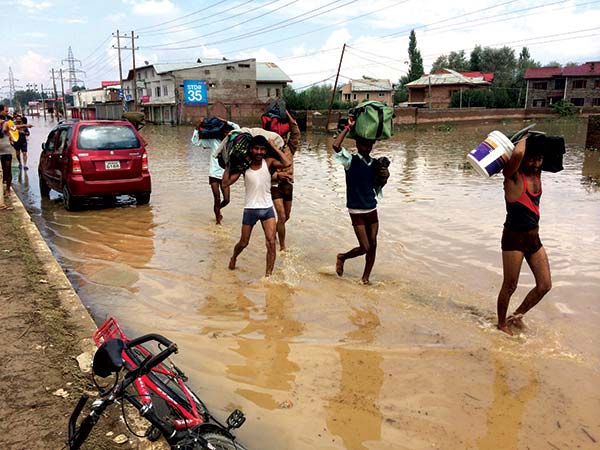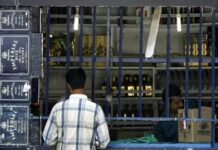Seasonal migration of labour is just a routine in Indian states. Kashmir’s for centuries have been moving out of the valley, mostly to Punjab, during harsh winters to make a living. A Kashmir Life report.

Most of the seasonal migrations out of Kashmir mostly comprise of those hawking various handicraft products. But what has changed over the years is that Kashmir has become a major destination for a reverse migration, mostly during summers. Apparently better wages, a cool environment and enough of work have been the main driving forces for the migrant labourers who number between 200 thousand to around half a million at the peak of summer.
Department of Sociology in the University of Kashmir carried out a survey about socio-economic status of this section of labourers. With Prof B A Dabla as the principal investigator and Dr Sofiya Hassan Mir as supervisor, there were seven research assistants (Shreen Tramboo, Anam Ganie, Shimalia Rather, Shugufta, Sabia Yousuf, Zeenat-un-Nissa and Usma Yousuf). 75 students went to the field in 2010 and met 4200 migrant labourers. Here is what they found out:
The Age Group
55.92% of the migrant labourers were in the age group of 19-30 years, about 20.64% belonged to 31-45 years and the rest (17.80%) were in 8-18 years age group. 79.85% were males and 1.95% were females. While 57.73% were married, 43% were unmarried.
Income Background
34% belonged to below Rs 5000 per month economic group and 55% had below Rs 10,000, a month. While 7.16% were making Rs 15,000 a month, 1.57% were in the 10-20,000 per month band. Only 0.38% were in the Rs 20,000 plus category.
Literacy
27% are literates and 73% illiterates
Language
They spoke varied languages: Hindi, Maithili, Bhojpuri, Gujarati, Rajasthani, Punjabi, Urdu, Nepali, Kashmiri and Bihari.
Origins
46.93% of the migrant labourers belonged to Bihar followed by 15.33% from UP. 8.86% belonged to Gujarat, 8.60% from Rajasthan, and 8.14% from West Bengal. From neighbouring Punjab there were 3.45%, from Nepal 0.83% and 0.31% from Jharkhand From all other places there were 13.69%.
Patterns
Only 5.97% of these labourers come to Kashmir for work during 1980-90 era for the first time. 20.19% came during 1990-2000 and most of them 51.19% started coming during 2000-2010.
Occupations
23.85% are unskilled labourers. Skilled include 17.40% of masons, 10.06% each are carpenters and painters, 3.40% are hairdressers, 1.23% are vegetable sellers, 1.05% are salesmen. Besides, 0.42% are agriculture labourers, 0.05% are cobblers, 0.23% are constructors, 0.95% are tailors, 0.53% are ice cream makers as the remaining 22% comprises of many other skilled lot that make small factions of the whole.
Motivators
51.16% – the majority of them came on their own but in 16% cases the ‘agents’ got them here. In 10.07% the employers brought them here and in 17.21% of the cases the contractors engaged them and got here. As many as 48.03% claimed they felt exploited.
Investments
28.04% of the labourers said their earnings in Kashmir are spent to improve the overall economy of the household back home, 14.99% spent it on constructing their houses,5.40% purchased land, 12.86% spent it on educating their children, 5.48% saved with banks, 5.84% spent on marriage, 3.07% spent on health and rest spent it on various family activities.
Wage improvement
In 72% of the cases, the labourers interviewed said they are earning better as compared to past at other places but 24% said they are making less than earlier. Due to an increase in their income, 61% said they are experiencing higher mobility.
Local Expenditure
Of whatever they are spending in Kashmir during their stay, 20% goes as rent, 19.52% on food, 20.45% on transport, 19.03% on the dress and 21% on other requirements.
Interaction
62.71% labourers say they have a positive interaction with the locals but 30.47% say it was not very positive. 63.47% like Kashmir culture while 2.52% disliked, the remaining 39.04% skipped responding to the query. 25.58% felt positive impact of the migration on their health unlike 33.47% who negated the idea. 12.66% felt moral/ethical problems in Kashmir while 46.74% faced no such problem. The rest remained non-committal.
Problems
The problems they faced included on account of accommodation (30.45%), health (14.53%), beggary (11.93%), wine consumption (9.05%), drug addiction (9.06%) and child labour (13.10%). 11.42% said they faced other problems.













